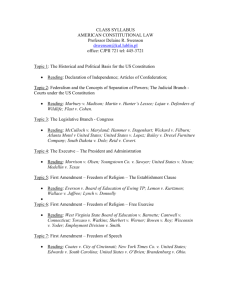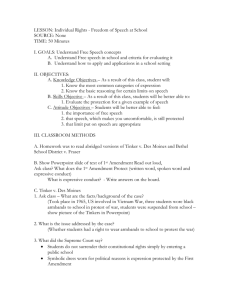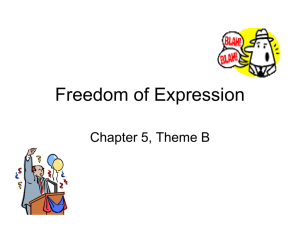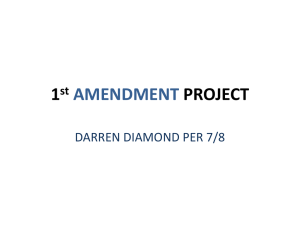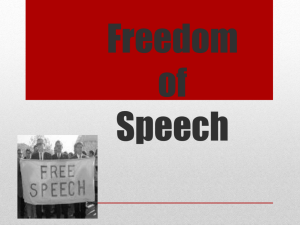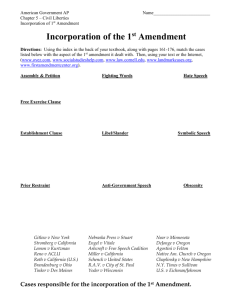Minarcini v. Strongsville City School District
advertisement
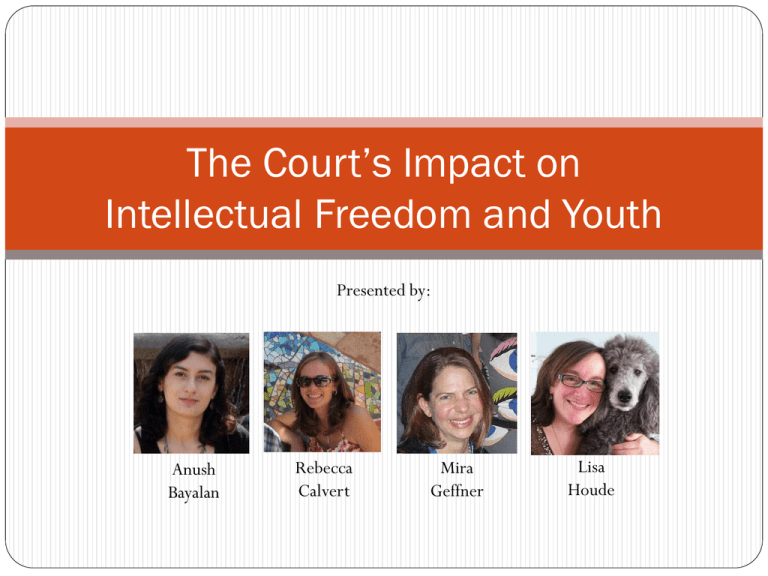
The Court’s Impact on Intellectual Freedom and Youth Presented by: Anush Bayalan Rebecca Calvert Mira Geffner Lisa Houde Cohen v. California (1971) Cohen v. California (1971) Paul Robert Cohen, age 19, arrested for wearing a jacket to the Los Angeles Courthouse with the words “Fuck the Draft” Convicted under California Penal Code 415 Disturbing the peace by “offensive conduct” Cohen v. California The U.S. Supreme Court overturned the decision because Cohen was exhibiting speech rather than conduct Cohen’s speech was not “fighting words” because they are not addressed to a specific person The wording for the Code is not specific because the public may not know what offensive conduct is Cohen’s speech is not obscene because it is not sexual in nature Cohen v. California “The constitutional right of free speech is powerful medicine in a society as diverse and populous as ours. It is designed and intended to remove government restraints from the arena of public discussion, putting the decision as to what views shall be voiced largely into the hands of each us , in the hope that use of such freedom will ultimately produce a more capable citizenry…” Justice Harlan Cohen v. California Viewpoint Important decision for freedom of speech The case confirms the idea that people can “avert their eyes” if they see something that they do not want to see The case confirmed the application of “fighting words” and “obscenity” Reno v. ACLU (1997) Reno v. ACLU (1997) Communications Decency Act, part of the Telecommunications Act of 1996 Criminalized the transmission of “obscene” or “indecent” material to minors Prohibited displaying text or images to minors relating to sexual or excretory activities or organs Reno v. ACLU The Supreme Court stated that the “indecent transmission” part of the CDA violated the Freedom of Speech clause of the First Amendment CDA would block material that was education or artistic It would be too difficult to check the age It is not only limited to commercial transactions It might block adults from their constitutionally protected right to view obscene or indecent material It did not give parents the freedom to choose what their child can see Reno v. ACLU Viewpoint Precursor to CIPA CDA did not pass because it was too broad, but COPA was narrow enough CDA did not give parents discretion, but CIPA did Bethel School District No. 403 v. Fraser Bethel School District v. Fraser 4/26/1983 Senior Matthew Fraser delivers sexually explicit speech to Bethel High School Students "I know a man who is firm -- he's firm in his pants, he's firm in his shirt, his character is firm -- but most . . . of all, his belief in you, the students of Bethel, is firm.” Caused hooting, yelling, sexual gestures, apparent embarrassment Bethel School District v. Fraser Bethel Rules: "Conduct which materially and substantially interferes with the educational process is prohibited, including the use of obscene, profane language or gestures." Fraser is suspended for 3 days, and his candidacy for graduation speaker is revoked Bethel School District v. Fraser Fraser takes case to the District Court, which rules in his favor Court of Appeals affirms District Court ruling Precedent of Tinker v. Des Moines Claims wording of school rules is overly vague Bethel School District v. Fraser Supreme Court upholds the school district’s decision Fraser was advised speech would be inappropriate and may face severe consequences Tinker concerned passive political expression, which did not intrude on the work of the school or rights of students Such speech is prohibited in formal halls governed by Rules of Debate Role of school to teach citizenship Disagree the student could not have anticipated the consequences Issues and Viewpoint What constitutes protected and unprotected speech in the academic setting? I agree with the Supreme Court ruling Not an example of political expression Caused clear disruption in student behavior and classroom instruction Assembly was mandatory, so students were forced to hear offensive language Board of Education v. Pico Board of Education v. Pico Board of Education, Island Trees Union Free School District No. 26, et al. v. Pico, by his next friend Pico, et al. (1982) Complaints: “anti-American, anti-Christian, anti-Semitic and just plain filthy” "obscenities, blasphemies, brutality and perversion beyond description" Board of Education v. Pico The Fixer, by Bernard Malamud; Slaughterhouse Five, by Kurt Vonnegut Jr.; The Naked Ape, by Desmond Morris; Down These Mean Streets, by Piri Thomas; Best Short Stories of Negro Writers, edited by Langston Hughes; Go Ask Alice, authorship anonymous; Laughing Boy, by Oliver LaFarge; Black Boy, by Richard Wright; A Hero Ain’t Nothin’ But a Sandwich, by Alice Childress; Soul on Ice, by Eldridge Cleaver; and A Reader for Writers, edited by Jerome Archer Board of Education v. Pico Decision: "Libraries afford [students] an opportunity at self-education and individual enrichment that is wholly optional." Issue: Can school board members remove books from the library based on the members’ personal values? Viewpoint: Students need access to information about different experiences and points of view to enrich their learning. No individual or group should be allowed to impose arbitrary criteria on the school library collection. Minarcini v. Strongsville City School District Minarcini v. Strongsville City School District Minarcini v. Strongsville City School District 541 F.2d 577 (6th Cir, 1976) Censors' complaint: (informal) “completely sick” and “garbage” (Reichman, 2001) Books removed Catch 22, by Arthur Heller Cat's Cradle, by Kurt Vonnegut Minarcini v. Strongsville City School District Decision: "a library is … an important privilege created by the state for the benefit of students in the schools … not subject to being withdrawn by succeeding school boards whose members might desire to 'winnow' the library for books the contents of which occasioned their displeasure or approval." Issues: Can a school board override teachers' selections of books for the school curriculum? Can a school board remove books from a school library? Viewpoint: No student is compelled to read the books in the library, or to engage with any given book held there. The library is there to support the students' right to read, which is an essential part of their intellectual freedom. Chaplinsky v. State of New Hampshire (1941) Chaplinsky v. State of New Hampshire Case Facts Devout Jehovah’s Witness Walter Chaplinsky arrested for violating a state statute after saying to the City Marshal “You are a God damned racketeer” and “a damned Fascist and the whole government of Rochester are Fascists or agents of Fascists.” Issues Raised Is speech that incites a breach of the peace protected by the First Amendment? Does the application of the state statute violate Chaplinsky’s freedom of speech protected by the First Amendment? Chaplinsky v. State of New Hampshire Decision Unanimous decision, courts upheld the arrest stating the state statute restricting speech was specific enough that it complied with the requirements of due process and did not unreasonably impinge on Chaplinsky’s First Amendment rights to free speech Decision articulated the fighting words doctrine, which limits the First Amendment’s guarantee of freedom of speech for all Americans Chaplinsky v. State of New Hampshire Viewpoint Free speech is not unlimited The term “Fascist” – fighting words? Interpretation of language, tone, place, context, and who the language is directed at – all important factors to determine whether speech is protected Major criticism by Caine (2004: “The ‘Fighting Words’ category was ill-conceived – is in disarray and poses a potent danger to speech that should command a premier protection.” Salvail v. Nashua Board of Education (1979) Salvail v. Nashua Board of Education Case Facts Nashua School Board member Alan Thomier exercising his strong religious and patriotic views, presented a formal resolution to withdraw copies of MS magazine from the high school library because it: Contained ads for vibrators, contraceptives, materials dealing with lesbianism and witchcraft, and gay material as well as ads for The Guardian – a pro-communist newspaper (his opinion) and ads which suggested trips to Cuba. Encouraged students to send away for records made by known communist folk singers. Dissenting board members requested that interim procedures already in place be followed; they were ignored and MS Magazine was removed and the subscription cancelled Salvail v. Nashua Board of Education Issues Raised Plaintiff 16-year-old Rhonda Salvail, along with an English teacher and several Nashua residents, claimed deprivation of due process and rights under the First Amendment and sued the Nashua Board of Ed. Did the board follow its own procedures in removing the magazine? Was the magazine a valid resource for study? Did it contain offensive material? Decision “The court finds and rules that the defendants herein have failed to demonstrate a substantial and legitimate government interest sufficient to warrant the removal of MS magazine from the Nashua High School library. Their action contravenes the plaintiff’s First Amendment rights, and as such, it is plainly wrong.” Salvail v. Nashua Board of Education Viewpoint This case, along with three other court cases, forms the foundation of the extended view of Freedom of Speech to include the right of minors to read using school library materials The ALA states as referenced in Adams (2010): “The freedom to read is essential to our democracy” (p. 59). And again, in the interpretation of the Library Bill of Rights, Adams (2010) quotes, “Children and young adults unquestionably possess First Amendment rights, including the right to receive information through the library in print, non print, or digital format. Constitutionally protected speech cannot be suppressed solely to protect children and adults from ideas or images a legislative body believes to be unsuitable for them” (p. 60). Questions? This concludes our presentation. Thank you for your time and attention! References References--Bayalan References--Calvert Fraser, M. Untitled speech. Retreived from http://law2.umkc.edu/faculty/projects/ftrials/conlaw/fraserspeech.h tml Legal Information Institute. Bethel school district No. 403 v. fraser (No. 841667) 755 F.2d 1356, reversed. Retrieved from http://www.law.cornell.edu/supct/html/historics/USSC_CR_0478_ 0675_ZS.html Siegel, P. (1987). When is a student’s political communication not political: Bethel school district vs. fraser. Communication education, 36 (4). Retrieved from http://www.tandfonline.com.libaccess.sjlibrary.org/toc/rced20/curre nt#.UmICHhAwe1c Weeks. R.A. (2012). The first amendment, public school students, and the need for clear limits on school officials’ authority over off-campus student speech. Georgia law review, 46 (4). Retrieved from http://www.law.uga.edu/ References--Geffner American Civil Liberties Union of Ohio. (n.d.). Free speech on the docket. Retrieved from http://www.acluohio.org/archives/cases/minarcini-vstrongsville-city-school-district Minarcini v. Strongsville City School District 541 F.2d 577 (6th Cir, 1976) Retrieved from http://openjurist.org/541/f2d/577 Reichman, H. (2001). Censorship and selection: Issues and answers for schools, 3rd Edition. Chicago: American Library Association. References--Houde Adams, H. R. (2008). Ensuring intellectual freedom and access to information in the school library media program. Westport, CT: Libraries Unlimited. Auguste, M. (2012). VOYA’s guide to intellectual freedom for teens. Bowie, MD: VOYA Press. Caine, B. (2004). The trouble with ‘fighting words’: Chaplinsky v. New Hampshire is a threat to first amendment values and should be overruled. Marquette Law Review, 88(3), Retrieved from http://scholarship.law.marquette.edu/cgi/viewcontent.cgi?article=1026&context=mulr Dorres, P. & Means, J. (n.d.). Chaplinsky v. State of New Hampshire. Retrieved from http://people.oregonstate.edu/~dorresp/CSSA%20Competencies/Examples%20for%20Portfoli o/Chaplinsky%20v%20final.pdf Hudson, D. L. (2012). ‘Fighting words’ case still making waves on 70th anniversary. Retrieved from: http://www.firstamendmentcenter.org/fighting-words-case-still-making-waves-on-70thanniversary Leagle.com. (2013). Salvail v. Nashua bd. of ed. Retrieved from http://www.leagle.com/decision/19791738469FSupp1269_11595 Reichman, H. (2001). Censorship and selection: Issues and answers for schools. Chicago, IL: American Library Association. IMAGES: http://identityrevolutionproject.wordpress.com/tag/fighting-words/ http://chronicle.com/blogs/linguafranca/2011/10/20/ms-40-years-on/ https://msmagazine.com/blog/2011/02/16/black-history-month-the-myth-of-the-blacksuperwoman-revisited/
